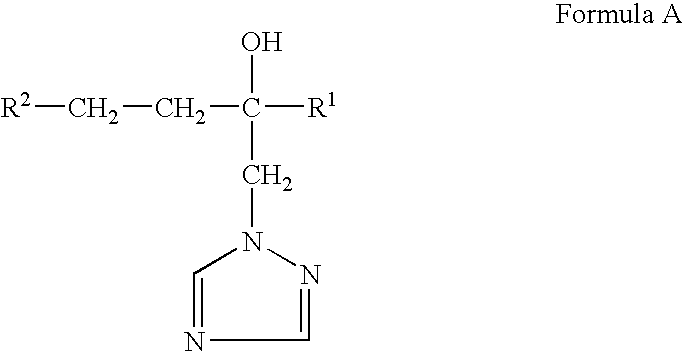Control of mold growth on wood
a technology for controlling mold growth and wood, applied in the direction of biocide, manufacturing tools, fibreboard, etc., can solve the problems of adversely prone to mold surface growth, and affecting the appearance of wood, so as to prevent mold growth in pressure treated wood
- Summary
- Abstract
- Description
- Claims
- Application Information
AI Technical Summary
Benefits of technology
Problems solved by technology
Method used
Image
Examples
examples
[0110] ACQ solutions were prepared for use in the following examples. Ratios of copper and quaternary ammonium chloride conform to the AWPA specifications previously described above.
[0111] For ACQ-C, “Cu-count-N” solution (1000 g, a copper ammonium carbonate solution containing 8% copper as the metal, available from Mineral Research Development Company, Harrisburg N.C.) was charged into a 2000 mL three neck-round bottom flask equipped with a mechanical stirrer and a thermometer. Then 280.2 g of ethanolamine was added, portion by portion, to the flask under stirring while controlling the temperature of the exothermic mixing so as not to exceed 45° C.. After stirring for 30 min., alkylbenzyldimethylammonium chloride (50.9 g, available from Aldrich, Milwaukee Wis. as benzalkonium chloride) was added and the mixture stirred for a further 30 min.
[0112] For ACQ-D, the procedure for ACQ-C was followed except that 63.7 g of an 80% ethanolic solution of didecyldimethyammonium chloride (ava...
PUM
| Property | Measurement | Unit |
|---|---|---|
| concentration | aaaaa | aaaaa |
| concentration | aaaaa | aaaaa |
| total concentration | aaaaa | aaaaa |
Abstract
Description
Claims
Application Information
 Login to View More
Login to View More - R&D
- Intellectual Property
- Life Sciences
- Materials
- Tech Scout
- Unparalleled Data Quality
- Higher Quality Content
- 60% Fewer Hallucinations
Browse by: Latest US Patents, China's latest patents, Technical Efficacy Thesaurus, Application Domain, Technology Topic, Popular Technical Reports.
© 2025 PatSnap. All rights reserved.Legal|Privacy policy|Modern Slavery Act Transparency Statement|Sitemap|About US| Contact US: help@patsnap.com



